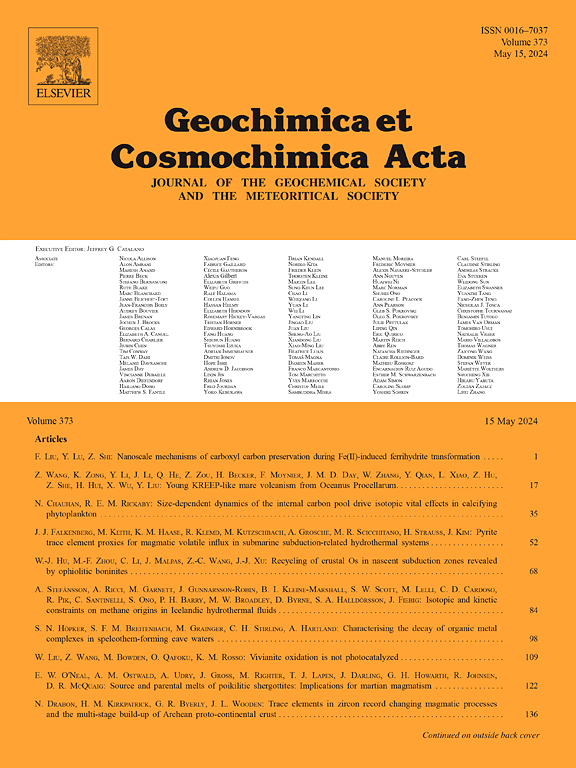Are scandium sulfate complexes effective in mobilizing scandium?
IF 5
1区 地球科学
Q1 GEOCHEMISTRY & GEOPHYSICS
引用次数: 0
Abstract
Sulfate has been increasingly acknowledged as a key ligand for the mobilization and enrichment of rare earth elements (REEs). Here, we report the results of an investigation of the solubility of Sc2O3(s), scandium speciation, and the coordination geometry of scandium species in sulfate-bearing solutions using solubility experiments and ab initio molecular dynamics (AIMD) simulations. The investigation was conducted for temperatures of 175 to 250 °C at vapor-saturated water pressure. From the results of our experiments, we conclude that Sc(SO4)2− is the dominant scandium species, and that its formation constant (log β1) varies from 11.20 ± 0.08 at 175 °C to 14.21 ± 0.12 at 250 °C. The AIMD simulations show that the Sc(SO4)2− complex is either doubly monodentate or has a mixed monodentate-bidentate configuration, and is coordinated with four water molecules. The species ScSO4 + was also identified in our experiments, but has a relatively low formation constant (log β2) varying from 7.24 ± 0.46 at 175 °C to 9.51 ± 3.50 at 250 °C. Modeling of the transport and deposition of scandium provides convincing evidence that sulfate scandium complexes can transport scandium efficiently in acidic fluids (pH below 4). Our simulations emphasize the critical roles played by fluid-rock interaction and fluid–fluid mixing in the genesis of scandium ores. This study presents the key thermodynamic data needed to evaluate scandium mobilization in sulfate-rich hydrothermal systems.
硫酸钪配合物能有效地调动钪吗?
硫酸盐作为稀土元素富集和活化的关键配体,越来越受到人们的重视。在这里,我们报告了利用溶解度实验和从头算分子动力学(AIMD)模拟研究Sc2O3(s)的溶解度、钪形态和钪在含硫酸盐溶液中的配位几何的结果。实验温度为175 ~ 250°C,水压力为蒸汽饱和。实验结果表明,Sc(SO4)2−是钪的优势种,其形成常数(log β1)在175℃时为11.20±0.08,在250℃时为14.21±0.12。AIMD模拟结果表明,Sc(SO4)2−配合物具有双单齿或单齿-双齿混合构型,并与4个水分子配位。在我们的实验中也发现了ScSO4 +,但其形成常数(log β2)相对较低,在175°C时为7.24±0.46,在250°C时为9.51±3.50。对钪运移和沉积的模拟提供了令人信服的证据,表明硫酸盐钪配合物可以在酸性流体(pH低于4)中有效地运移钪。我们的模拟强调了流体-岩石相互作用和流体-流体混合在钪矿石成因中的关键作用。本研究提供了评估富硫酸盐热液系统中钪运移所需的关键热力学数据。
本文章由计算机程序翻译,如有差异,请以英文原文为准。
求助全文
约1分钟内获得全文
求助全文
来源期刊

Geochimica et Cosmochimica Acta
地学-地球化学与地球物理
CiteScore
9.60
自引率
14.00%
发文量
437
审稿时长
6 months
期刊介绍:
Geochimica et Cosmochimica Acta publishes research papers in a wide range of subjects in terrestrial geochemistry, meteoritics, and planetary geochemistry. The scope of the journal includes:
1). Physical chemistry of gases, aqueous solutions, glasses, and crystalline solids
2). Igneous and metamorphic petrology
3). Chemical processes in the atmosphere, hydrosphere, biosphere, and lithosphere of the Earth
4). Organic geochemistry
5). Isotope geochemistry
6). Meteoritics and meteorite impacts
7). Lunar science; and
8). Planetary geochemistry.
 求助内容:
求助内容: 应助结果提醒方式:
应助结果提醒方式:


